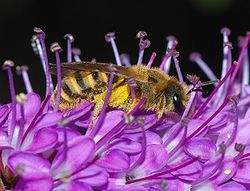Halictinae
| Halictinae | |
|---|---|
 |
|
| Halictus scabiosae | |
| Scientific classification | |
| Kingdom: | Animalia |
| Phylum: | Arthropoda |
| Class: | Insecta |
| Order: | Hymenoptera |
| Suborder: | Apocrita |
| Superfamily: | Apoidea |
| Family: | Halictidae |
| Subfamily: | Halictinae |
| Tribes | |
Within the insect order Hymenoptera, the Halictinae are the largest, most diverse, and most recently diverged of the four halictid subfamilies. They comprise over 2400 bee species belonging to the five taxonomic tribes Augochlorini, Thrinchostomini, Caenohalictini, Sphecodini, and Halictini, which some entomologists alternatively organize into the two tribes Augochlorini and Halictini.
The subfamily Halictinae also belongs to the hymenopteran monophyletic clade Aculeata, whose members are characterized by the possession of a modified ovipositor in the form of a poisonous sting for predator and prey defense. Including all eusocial and cleptoparasitic Halictidae taxa, these small bees are pollen feeders who mass provision their young and exhibit a broad spectrum of behavioral social polymorphies, ranging from solitary nesting to obligate eusociality. Estimated from the fossil record, eusociality in this subfamily evolved about 20 to 22 million years ago, which is relatively recent in comparison with other inferred eusociality origins. Thus, the Halictinae are believed to model the primitive eusociality of advanced eusocial hymenopterans. Because of their polymorphic sociality and recently evolved eusociality, the Halictinae are valuable to the study of social evolution.
The roughly 250 species belonging to the tribe Augochlorini exist only in the New World, mainly inhabiting the Neotropics and some areas of North America. Augochlorini sociality, though not well understood, is significantly polymorphic across its range, as well as between and within species and genera. Facultative eusociality has been observed in genera such as Augochloropsis and Megalopta, and cleptoparasitism has recently developed separately in the three augochlorine genera and subgenera Temnosoma, Megalopta (Noctoraptor), and Megammation (Cleptommation).
...
Wikipedia
